 |
 |
 |
| |
Distinct lipidomic signatures between persons living with HIV and seronegative persons: combined analysis of the ACTG 5260s and the MACS/WIHS Combined Cohort Study
|
| |
| |
Virtual 2020 International Workshop on Comorbidities & Adverse Drug Reactions in HIV
Reported by Jules Levin
Jennifer Jao, Lauren Balmert, Shan Sun, Grace A. McComsey, Todd T. Brown, Phyllis C. Tien, Judith Currier, James H. Stein, Yunping Qiu, Irwin J. Kurland, and Derek LeRoith
Distinct lipidomic signatures between persons living with HIV and seronegative persons: combined analysis of the ACTG 5260s and the MACS/WIHS Combined Cohort Studies....... "ART-naive PLHIV have a unique lipidomic signature primarily composed of higher unsaturated TAGs, suggesting an inflammatory state"
J Jao1, LC Balmert2, S Sun3, GA McComsey4,
TT Brown5, PC Tien6, J Currier7, JH Stein8, Y Qiu9, IJ Kurland9, D LeRoith10
1Northwestern University Feinberg School of Medicine, Department of Pediatrics, Division of Pediatric Infectious Diseases, Department of Medicine, Division of Adult Infectious Diseases; 2Northwestern University Feinberg School of Medicine, Department of Preventive Medicine, Division of Biostatistics; 3Ann and Robert H. Lurie Children's Hospital of Chicago, Department of Pediatrics, Division of Pediatric Infectious Diseases; 4University Hospitals Cleveland Medical Center and Case Western Reserve University, Cleveland, OH, USA, Department of Pediatrics, Department of Medicine; 5Johns Hopkins University, Baltimore, MD, USA, Department of Medicine, Division of Endocrinology, Diabetes, and Metabolism; 6University of California, San Francisco, Department of Medicine and Department of Veterans Affairs Medical Center, Division of Infectious Diseases; 7University of California, Los Angeles, CA, USA, Department of Medicine, Division of Infectious Diseases; 8University of Wisconsin School of Medicine and Public Health, Department of Medicine, Cardiovascular Medicine Division; 9Albert Einstein College of Medicine, Bronx, NY, USA, Stable Isotope and Metabolomics Core Facility, Department of Medicine, Fleischer Institute for Diabetes and Metabolism; 10Icahn School of Medicine at Mount Sinai, Department of Medicine, Division of Endocrinology
Objectives/aims: HIV and antiretroviral treatment (ART) cause metabolic derangements, but the distinct effects of HIV infection and ART on specific metabolic pathways are not known. We assessed the association of HIV and ART on the metabolome and lipidome.
Methods: We performed widely-targeted metabolomic and lipidomic profiling of plasma from ART-naive per- sons living with HIV (PLHIV) before and after initial ART therapy in the AIDS Clinical Trials Group study A5260s and in HIV-seronegative participants from the Multicenter AIDS Cohort Study/Women's Interagency HIV Study Combined Cohort. For this analysis, PLHIV who did not meet criteria for successful treatment (HIV RNA level <20 copies/ml by 24 and through 96 weeks of ART with no ART interruptions) were excluded. HIV-seronegative participants were frequency-matched by age, sex, race and body mass index (BMI). Metabolites and lipid subspecies were measured via mass spectrometry (Sciex 6500+ QTRAP). Orthogonal partial least squares discriminant analysis (OPLS-DA) and volcano plots were used to assess if differences in metabolites and lipid subspecies discriminated between HIV- seronegative participants and ART-naive PLHIV as well as ART groups.
Results: Of 435 participants, 218 were PLHIV (75 randomized to RAL-based, 77 to DRV/r-based, 66 to ATV/r-based ART) and 217 were HIV-seronegative. All PLHIV received a backbone of tenofovir/emtricitabine. Prior to ART initiation, PLHIV were slightly younger (37 versus 44 years), compared with seronegative participants, but race, sex, BMI and history of dyslipidaemia were similar between groups. In addition, 58 (27%) PLHIV had CD4 count <200 cells/mm3 and 49 (22.5%) had an HIV RNA level >100,000 copies/ml. OPLS-DA indicated that metabolites and lipid subspecies could distinguish between individual comparisons of HIV- seronegative participants with ART-naive PLHIV, PLHIV after 96 weeks of raltegravir (RAL)-based ART and PLHIV after 96 weeks of darunavir/ritonavir (DRV/r) or atazanavir/ritonavir (ATV/r)-based ART. Volcano plots of the metabolites identified by OPLS-DA with variable importance in projection (VIP) values >1 demonstrated that ART-naive PLHIV had a unique lipidomic imprint primarily driven by higher levels of triacylglycerols (TAGs) having polyunsaturated fatty acid (FA) side chains (Figure 1A), suggesting an inflammatory predisposition. RAL-based ART was associated with a shift in the lipidome such that unsaturated TAGs were lower compared with HIV-seronegative participants (Figure 1B). However, DRV/r- or ATV/r-based ART promoted a shift in the lipidome characterized by both higher unsaturated TAGs and higher saturated TAGs with shorter mono/saturated FAs, compared with HIV-seronegative participants (Figure 1C), suggesting both a lipogenic and inflammatory propensity.
Conclusion: ART-naive PLHIV have a unique lipidomic signature primarily composed of higher unsaturated TAGs, suggesting an inflammatory state ameliorated by RAL-based ART. In PLHIV on ART, we observed ART class lipidomic response differences (RAL versus DRV/r or ATV/r) compared with HIV-seronegative persons that may identify individuals at higher risk for derangements in specific metabolic pathways involving lipogenesis.
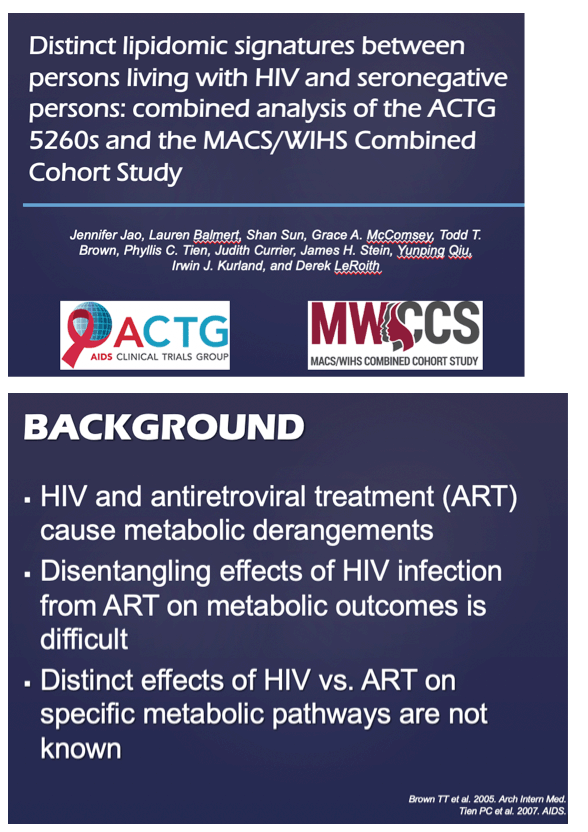
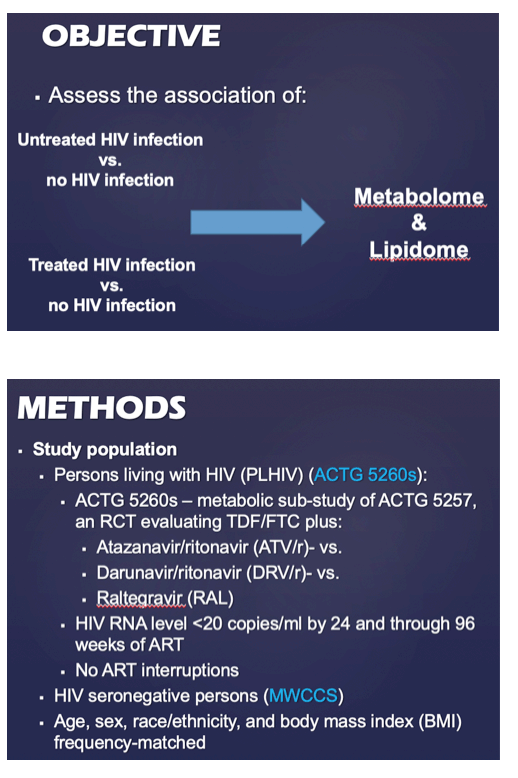
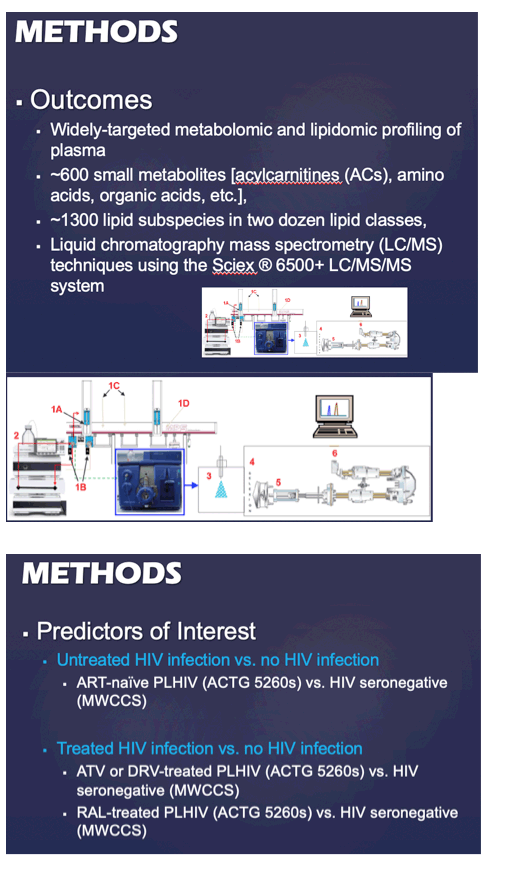
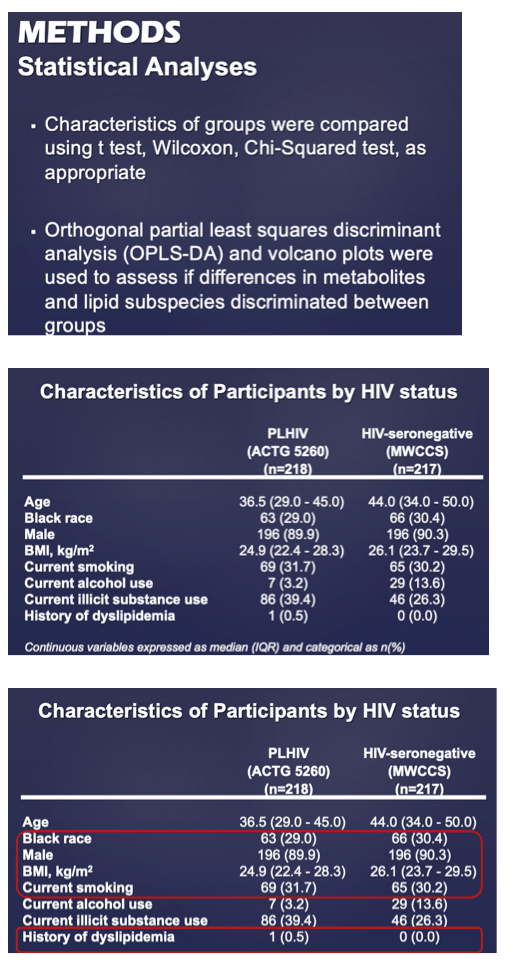
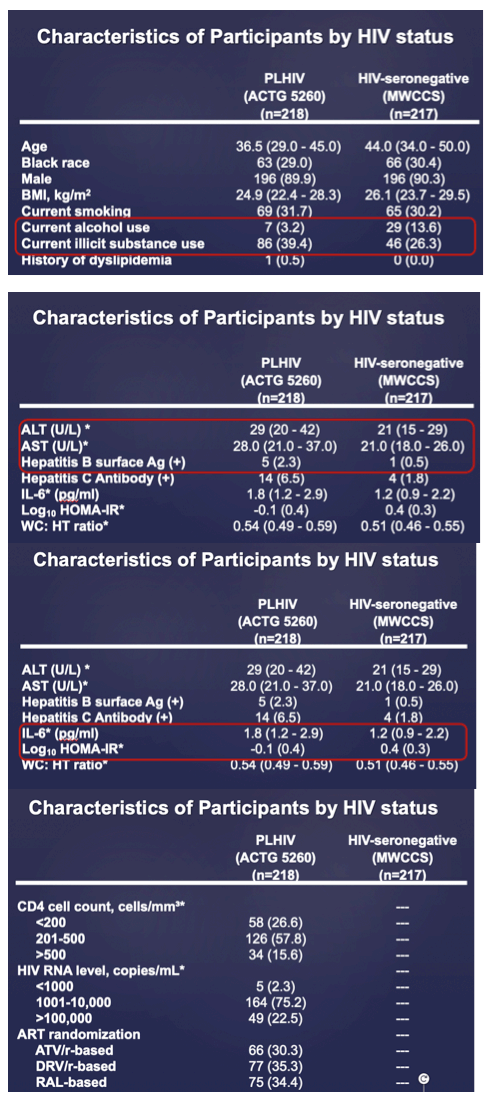
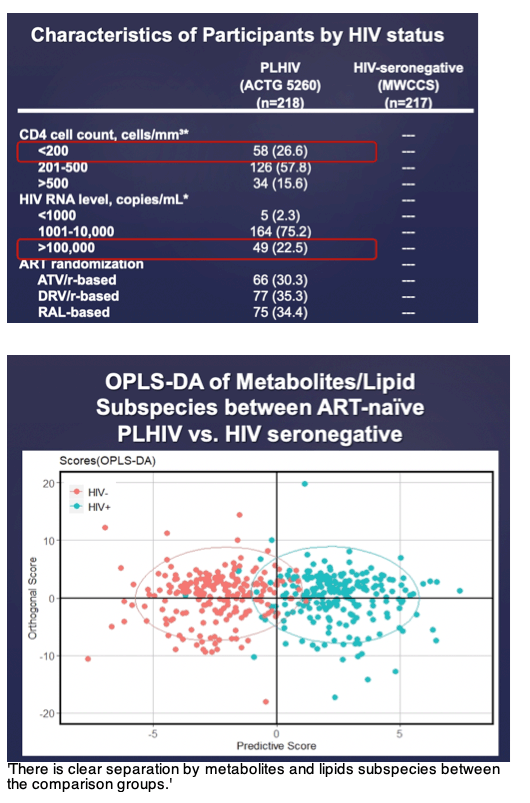
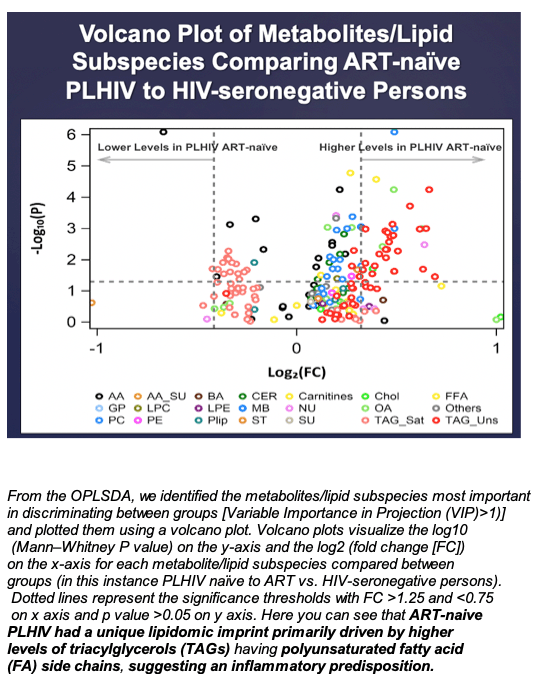
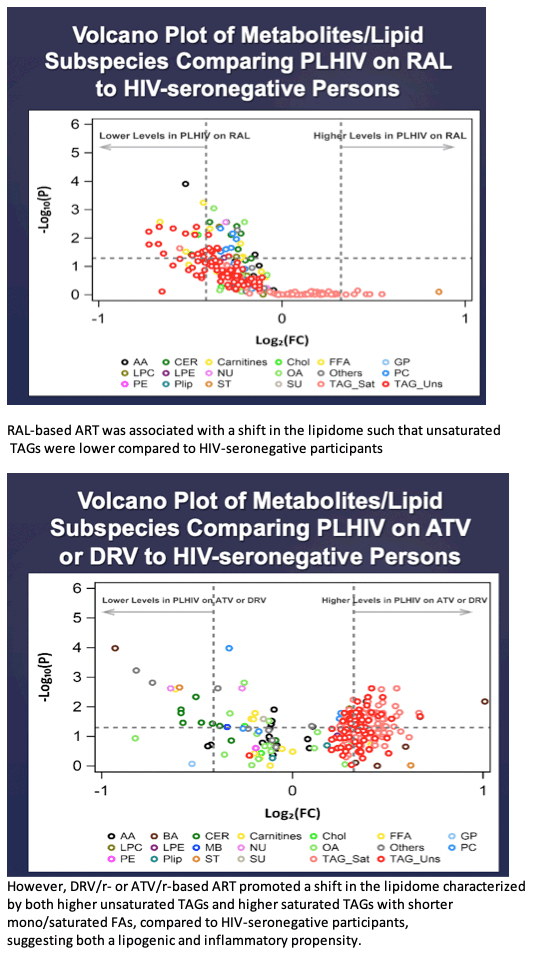
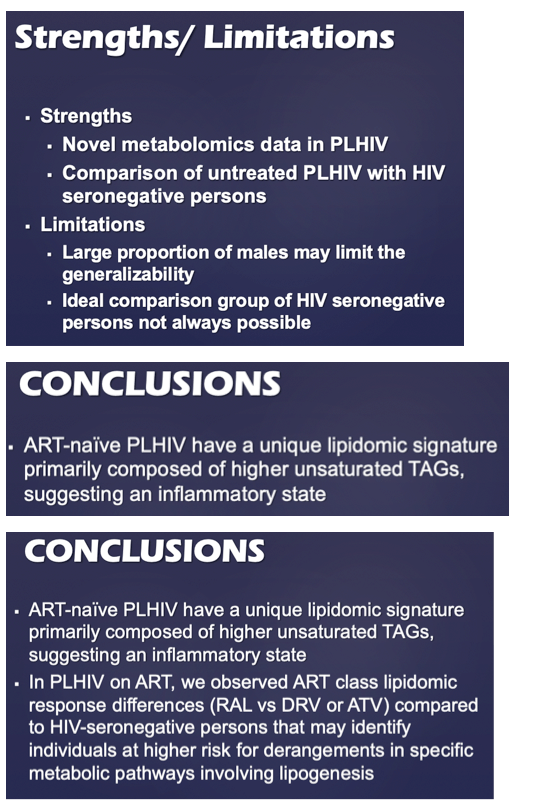
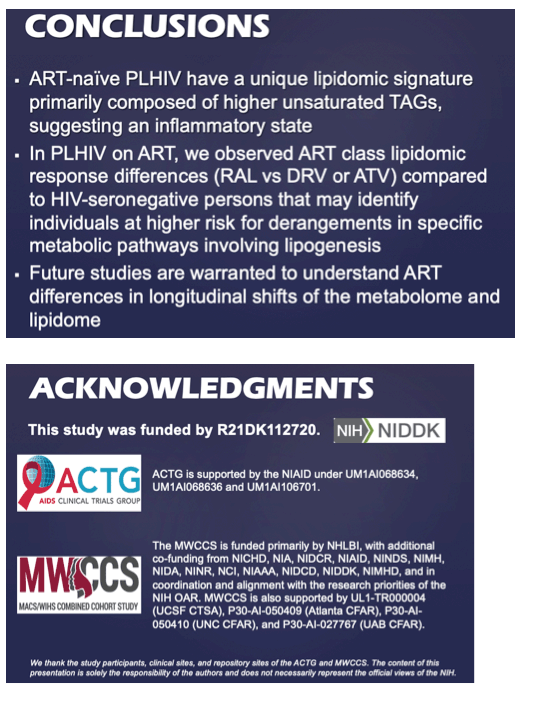
|
| |
|
 |
 |
|
|